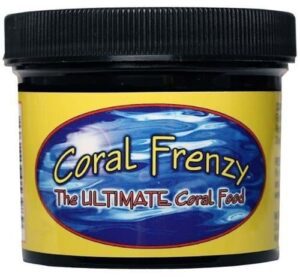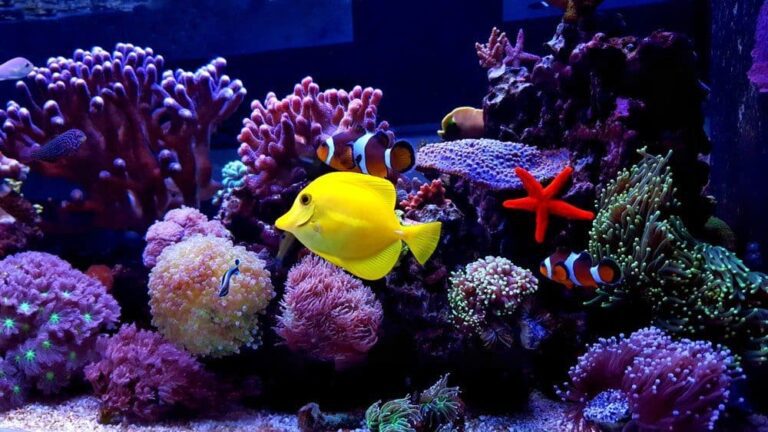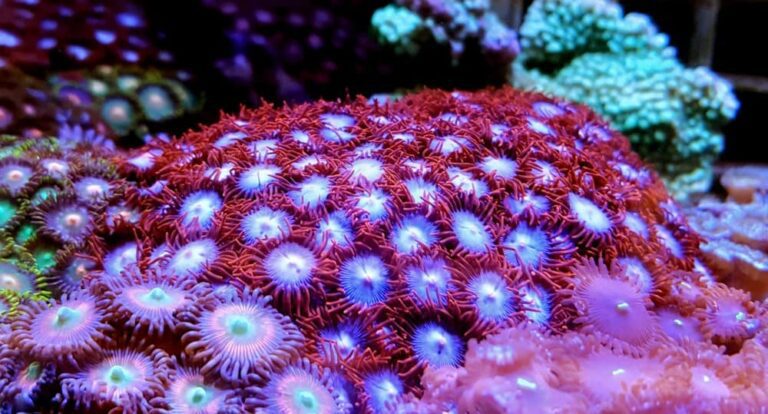You’ll have to take care of a lot of things in order to grow and maintain a reef tank full with corals.
To grow corals, providing them with the best food is one of the most important things. As corals are very delicate, in order to survive they need balanced nutrition which comes from the food.
On the other hand, just only feeding the best food won’t do all the work. You’ll also have to know the correct way to feed corals. Not only that, to maintain a perfect reef tank you’ll have to learn a bunch of basics about corals.
So, in this article, along with the best food for corals, we have covered up all the related information that one would need to successfully grow and maintain a reef tank.
So without further ado, let’s get started.
Top 5 Best Coral Foods Reviewed
The right food and the proper amount are highly important for growing and sustaining corals. However, right now the market is loaded with low-quality coral foods which makes it really hard for newbies to choose the best one for their tank. In order to help you with the selection, we have designed a list of 5 best foods for corals.
Table could not be displayed.These foods made their way to this review list by their capabilities. Each of the food has the highest rating and positive user feedback in the market. Moreover, we have tried to contact some users and also got a positive response from them. But still, there are a few tiny drawbacks which we have mentioned in the review.
Here are our reviews:
1. Polyp Lab Reef-Roids – Overall Best Coral Food
Staring the list with the highest-rated coral food in the market, the Polyp Lab Reef-Roids. This food contains natural marine planktons and some zooplankton that you would not find in most other coral food brands. This product is very popular as it delivers noticeable response and polyp extension which is awesome for corals.
On the other hand, this polyp lab reef-roids also protects water from degradation which is an added benefit of owning this food. This Reef-roids is good for broadcast feeding, just disperse the food in the high water flow area. This one is highly recommended for target feeding too.
You can use a turkey baster, syringe or other similar tools to deliver the food in an area from where corals will easily be able to get that. A syringe is the most used tool for target feeding.
This food is for normal use. It is not meant to make a reproducing plankton province. Another good thing of this coral food is, with normal use the container will last for about 3 months.
Overall, this is a good choice for target feeding for the aggressive corals but that’s doesn’t mean you can’t use it for broadcast feeding.
- All natural ingredients.
- Best for target feeding.
- Comes in a handy container.
- Highly-Concentrated.
- Lasts for about 3 months.
- We have seen some users complaining about the lid of the container getting lose after a few rounds of use.
2. Coral Frenzy Review
The coral frenzy is an all-rounder coral food. Whether you are a newcomer or a professional, this coral food is suitable for everyone. And the best part about this product is, you are not getting food only for the corals but for the entire tank.
Yes! The coral frenzy is formulated to feed all the organisms in the aquarium such as small fishes, SPS, LPS, crustacean, scallops and many more. People who are new in this area, who don’t know what to feed corals and how to maintain the tank to grow nicely, the coral frenzy will be a great choice for them.
Now let’s talk about which ingredients actually this food contains. It has natural phytoplankton and zooplankton. Here is an interesting part, when zooplankton is busy at feeding the corals, phytoplankton is feeding the microfauna which will feed the coral later when they are done with the zooplankton. Plus, it also has a blend of roe, copepods and larvae’s.
In this coral frenzy, there are no hidden ingredients unlike some other brands and everything is natural. To put it simply, the coral frenzy is a high-quality product which can be used by both newcomer and professionals.
- It has a blend of copepods, roe, and larvae.
- It will feed the entire tank.
- Contains all the natural ingredients.
- Best for both newcomers and professionals.
- The quantity is low compared to others.
3. Two Little Fishies Marine Snow – Best Coral Food With Biogenic Matters
One thing why people are loving Two Little Marine Snow so much is because it contains biogenic matter which exits in the seawater. That’s a really important part of any marine animal’s food chain. Two little marine snow is one of the very few products that contain biogenic matters.
And like others, this food also contains the necessary ingredients phytoplankton and zooplankton that are required for corals. These two ingredients provide all the basic nutrients for the corals and corals also response fast for these foods.
Overall, the two little fishier marine snow can be a great food for your corals as they replicate the seawater biogenic matter. Plus, you can use any feeding method with this product. But if you store the food in the refrigerator, take it out 15 minutes before feeding. It will give the food time to go back to regular temperature.
- Replicates seawater biogenic matter.
- Helps the corals to flourish.
- Coral responses perfectly.
- Suitable for any type of feeding method.
- It can get really thick when kept in a refrigerator.
4. Seachem Reef Phytoplankton – Best Coral Food For Coloration
Well, the Seachem Reef has a blend of brown and green phytoplankton which is meant to deliver the required proteins, fatty acids, amino acids, vitamins along with biological carotenoids for corals. This single product is enough to feed a large number of marine animals of an aquarium.
This food also contains the natural source of carotenoids which delivers protein as well as bio-available sources of pigmentation. On the other hand, it also increases and balances the ratio of protein, vitamin b, lipids, fatty acid, carbohydrates, etc. You can use any kind of feeding method with this food.
All in all, this Seachem reef phytoplankton is a reliable food for corals. We liked the fact that this food balances and provides all the essentials that are necessary for growing corals.
- Delivers all the essentials for corals.
- Combination of brown and green phytoplankton.
- Contains all the natural ingredients.
- Suitable for any type of feeding technique.
- It smells really bad.
Coral Foods That We Reviewed Separately –
5. Kent Marine PhytoPlex – Best Coral Food For SPS Corals
And here comes the last coral food in our review list, the Kent Marine PhytoPlex. This Kent Marine PhytoPlex has a balanced ratio of the lipids, carbohydrates, and protein which are essential for any type of corals. Kent uses their very own formula to deliver the saltwater experience.
One thing that people really love about this product is, it is not suitable only for corals but also for scallops, sponges, clams and few others too. In one sentence, this product will take care of the entire bottom layer of your aquarium.
This coral food is recommended for SPS corals which means you can to follow the broadcast feeding method.
- It has natural phytoplankton.
- Recommended for SPS corals.
- Gluconates free.
- Added sugar-free.
- Reasonably priced.
- It delivers a large amount of food very fast, so there is a risk of overfeeding.
What is the Best Food for Corals?
Already we have discussed 5 foods that are best for corals. But if you want a specific one then we would choose Coral Frenzy for some obvious reasons.
Your tank requires a lot of things and the coral Frenzy comes with all the required ingredients that any tank requires. It’s like vitamins that human needs. We need a balanced ratio of all the vitamins and our regular food doesn’t contain all of the needed vitamins. That is why people go for multi-vitamin tabs or capsules where they have all kind of needed vitamins for the human.

So Coral Frenzy is kind of the same thing that is formulated to feed all organisms in your tank. This one is actually the best choice for newcomers as it will help them to maintain a balanced nutrient level in the tank.
As I said earlier, Coral Frenzy is formulated to feed maximum organisms of the tank so there is less chance of uneaten food floating on the water. On the other hand, it helps a lot to keep the entire tank clean which is really important not only for corals but also for all the inhabitants in the tank.
What are the Types of Corals?
Mainly there are two types of corals: SPS (Small polyp stony) and LPS (large polyp stony). Both types of corals are similar to each other but there are some big differences too.
Let’s take a closer look at them:
SPS Corals: These corals have little polyps on the stony skeletal base and they generally resemble flowers. Small polyp stony corals need a strong current of high-quality water and they are open to negative nitrate effects. It would be very tough to grow an SPS coral with no adequate bright light. They are of calm nature.
LPS Corals: On the other hand, these corals come with large fleshy polyps and strong skeleton base. LPS corals need a medium to high light level to develop nicely and move with the currents of water.
Large polyp stony corals are also well known because of their ability to sting. They are really aggressive and will sweep up other corals from their area. Overall, they are not friendly to their neighbor.
In order to choose the best food for both type of corals, there are a lot of things that should be taken into account. Though both of them rely on the same nutrients, the way they get their foods are very different.
Large polyp stony corals are way more aggressive than the small polyp stony corals, so you would want to give food in a way so that both of them can get to eat the food equally.
On the other hand, how much are you feeding them also matters. An excessive amount of wrong foods will cause long-term issues for both your coral and other marine inhabitants sharing the same tank.
Foods that we have reviewed earlier are perfectly fine for both corals. However, make sure you feed them in a limited amount and be aware of the LPS corals.
What Else Coral Eats?
All kind of corals mostly relies on the phytoplankton. Phytoplankton is generally very small, sometimes even microscopic. Corals also eat organisms that move slow and easy to hunt such as floating plankton or larvae.
Some corals also eat zooplankton but sometimes they are tough to catch for SPS corals. LPS corals don’t struggle much to hunt down floating zooplankton.
Bacterioplankton is another great source of nutrients. They are also known as reef snow. Bacterioplankton contains bacteria. Some bacteria are free-living and some are associated with different materials in the water. All corals feed Bacterioplankton heavily.
Another thing that corals eat are the dissolved organic materials in the water. Corals absorb these DOM (dissolved organic materials) by their cell membrane. Corals which has large polyps (LPS) can catch and eat large items such as small fishes.
On the other hand, soft coral decides their food by the size. LPS corals can easily capture and eat moving items as they are more aggressive compared to the SPS.
How Does Coral Eat?
Corals need signals to get ready to eat. The signal can be anything:
- Light change
- Temperature change.
- Oxygen level change.
- Movement in water.
All the above-listed things give coral the signal that it’s time to eat. These signals go to corals’ roots and notify them of the increasing amount of plankton in the surrounding area.
In the ocean, coral eats once the sun goes down. And planktons also come out when the light fades. So when the light goes off corals open their polyps and starts ingesting planktons that cross their way.
Light plays a very important role for corals to grow and thrive. To know more you can read our article on best LED reef lights.
The barbs of the coral kill any plankton that comes in contact with them. Once plankton is killed, the tiny tentacles pull that into the coral’s mouth.
Moreover, corals use stringers in order to draw foods towards them like sea anemones and jellyfish. During the day, corals hide their tentacles inside the skeletons. Once they get a signal, the tentacles come out and ingest any plankton that comes in contact.
By now you might have guessed how hard is it to feed corals. Feeding fishes are way too easy. However, different types of corals require different treatments. Once you spend some time with them you’ll get to know how they should be fed.
How to Feed Corals?
Just dropping the right amount of pellet or flakes is all you would need to do for feeding fishes but in the case of corals, it’s much more complicated. You still need to know about your corals and what they need to develop, even though most coral foods come with all nutrients.
If you don’t know what the corals would eat and what is the proper amount, then you will see uneaten food floating on the water. Uneaten food lessens the nutrient level and it is harmful to all the creatures in the tank.
There are two types of famous methods to feed corals. We have broken them down below:
Broadcast Feeding:
In this method, with the help of the current from the pump or in any other way you would stir up the water and dispel the coral food so that the food can spread throughout the entire tank evenly. Broadcast feeding is very famous.
As the food spreads in the entire tank, it also nourishes the fishes. But in this method, it is highly important to keep in mind that, you should feed the coral the right food and in the right amount. Broadcast feeding method is an uncontrolled way of feeding corals, so it is easy to make mistake by giving too much food which will be a threat to the entire tank.
Target Feeding:
In this method, you’ll need a syringe or something similar which will be used to deliver the food directly to the corals. That means, food will not be all over the tank, it will be only there where you want it to be. Target feeding method can be a great way for keeping the water healthy.
If you have fish or any other creature in the fish tank, then you would need to feed them separately. Another thing that you should know is, target feeding method will be a great option for Large polyp stony corals, as they are very aggressive.
On the other hand, the broadcast method will be perfect for calm natured corals like small polyp stony. It is because the food will be all around the tank which makes it easier for non-aggressive corals to eat food from anywhere.
Importance of Corals
We know corals look very pleasing but there are very few who know the importance of corals. In recent days, corals have suffered really hard due to some changes such as global warming, polluted waters, overfishing etc. To save corals, first, we’ll need to know why they are so important.
Here are why corals are so important:
- Whether it is small fish or the large ones, all of them find both food and shelter in the corals. Without corals, sea life will come to an end within no time.
- Corals are the natural water filters. Most of the corals and sponges ingest particles from the ocean which enhances the clarity of the water. Ever thought why some sea water looks so crystal clear? Corals and sponges are one of the reasons.
- Moreover, coral reef protects the coast from strong waves and currents. What they do is, they slow down the water flow. One interesting thing about coral reefs are, they incline from where there is strong wave pressure or currents.
- When it comes down to fish tanks. Corals will also help to keep the aquarium water fresh and clean. They will consume most of the fish waste and fishes on the tank will use these corals as a nursery ground. Sometimes fishes find food on the coral reefs too. And lastly, a fish tank filled with coral reefs looks immensely beautiful.
You may find it interesting – How To Frag Corals
Frequently Asked Questions
Which nutrients do corals need?
Can I grow coral in a fish tank?
Do fishes eat corals?
Why is coral an animal?
Final Words
Growing and maintaining a tank of corals is not as easy as growing fishes. Fishes don’t require a lot of your time, just give them food and keep the water clean and that’ll be all.
But in the case of corals, as I have said you’ll have to take care of a lot of things. From their food to keeping the water well balanced, all require a lot of skills.
We hope this list of best food for corals will help you to choose the best one for your corals. Along with the review, we have also covered all the required information that will help you to grow and maintain corals.
If you have any more question, do not hesitate to ask on the comment section below!











